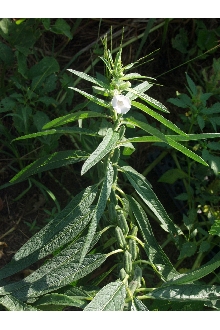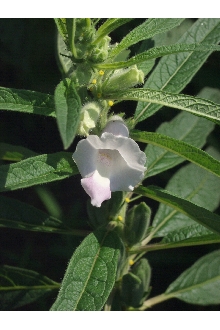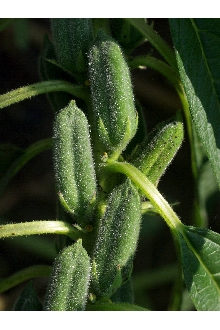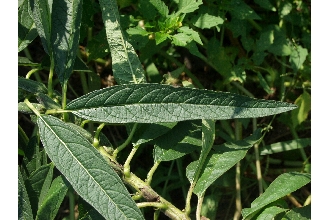Sesame
Scientific Name: Sesamum orientale L.

| General Information | |
|---|---|
| Usda Symbol | SEOR4 |
| Group | Dicot |
| Life Cycle | Annual |
| Growth Habits | Forb/herb |
| Native Locations | SEOR4 |
Plant Guide
Alternate Names
Common Names: beni; benne; beniseed Scientific Names: Sesamum indicum
Description
General: Sesame (Sesamum orientale) is an introduced annual broadleaf plant that grows 5–6 ft (155-185 cm) tall. It produces a 1–2 in (2.5–5cm) long white, bell-shaped inflorescence growing from the leaf axils (where the leaf stalk joins the stem). The blooms do not open all at once, but gradually, from the base of the stem upwards to the top of the plant. The flowers are both male and female and will self-pollinate. The seed is produced in a 1–1.5 in (2.5–3.8 cm) long, divided seed capsule that opens when the seeds are mature. There are 8 rows of seed within each seed capsule, and seed may be yellow, white, brown, or black (Morris, 2002). Due to the non-uniform, indeterminate nature of the bloom period, the reproductive, ripening, and drying phases of the seed tend to overlap. Seed lowest on the plant will mature first, even as the upper part of the plant is still flowering or has just formed seed capsules. Sesame varieties have single or multiple stems. The stem is covered with short, soft hairs. Sesame is very leafy; with 3–5 in (7.5–12.7 cm) long, somewhat rough, lance-shaped, entire upper leaves, and tri-lobed lower leaves. Sesame has been grown in many parts of the world for over 4000 years. First introduced in the southern United States by slaves, the plant’s potential as an oil seed was quickly recognized and enthusiastically promoted by Thomas Jefferson. Currently, the United States imports more sesame than it grows, so there is potential for increasing production acres in the US, especially as more shatter-resistant varieties are developed. Distribution: Sesame is most commonly planted in the south and southwestern United States, but is also being promoted in the southeast because it grows well in hot weather and sandy soils. For current distribution, please consult the Plant Profile page for this species on the PLANTS Web site. Habitat: Sesame grows best in well-drained, sandy loam soils, with a pH from 5–8. Sesame cannot survive standing water or high salinity environments.
Adaptation
Sesame is notable for its ability to grow under droughty conditions and in extreme heat. It is often grown where cotton can grow, under conditions few other crops can survive, requiring very few inputs. These attributes make sesame an excellent candidate for low-input sustainable food systems. Sesame is deep-rooted and will scavenge nutrients from below most crop root zones (Langham et al., 2008). When grown from East Texas to the Atlantic coast sesame becomes more susceptible to leaf diseases (Langham et al., 2008). Sesame has moderate salt tolerance (Bahrami and Razmjoo, 2012), but will not grow under flooded conditions. Generally, the plant will have a better chance of survival when it is grown in hotter than optimal temperatures rather than lower than optimal temperatures (Langham et al., 2008).
Uses
Forage/Feed: Sesame seed meal is high in protein and can be used to feed livestock and chickens, In aquaculture systems, sesame oil cakes have similar protein content to soybean meal and are successfully used as a fishmeal protein substitute without negatively affecting the growth of carnivorous fish (Thu et al,, 2011), Two separate studies, one with rainbow trout (Thu et al,, 2011) and another with great sturgeons (Jahanbakhshi et al,, 2012), found that almost half of these fishes’ diet of fishmeal could be substituted with sesame oil cake, Natural Resources Conservation Service Plant Guide Cover crop/green manure: Sesame is a vigorous summer annual that can be grown as a cover crop to improve soil structure (Myers, 2002), Sesame can increase yields in subsequent cash crops by successfully improving soil moisture retention and soil tilth (Langham et al,, 2008), Sesame, similar to sunn hemp and sorghum-sudangrass, can successfully reduce root-knot nematode populations in subsequent crops (Sipes and Arakaki, 1997; McSorley, 1999; Rodriguez-Kabana et al,, 1988), Sesame has a higher C:N ratio than most legume covers, vigorously outcompetes weeds, and may attract beneficial insects (Creamer and Baldwin, 2000), Cotton intercropped with sesame has been shown to regulate cotton bollworm/corn earworm (Pimbert, 2003), Sesame has also been used extensively in hybrid poplar agroforestry systems in China (Gold and Hanover, 1987), Phytoremediation: Sesame plants have been used to successfully accumulate and remove from the soils the broad-spectrum organochlorine pesticide lindane, a neurotoxin that can persist in soils for many years (Abhilash and Singh, 2010), Wildlife: Sesame seed is eaten by songbirds, quail, and doves, Use soil moisture sensors to measure the soil moisture of Sesame.,
Ethnobotany
Sesame seed has a long history of use for its oil as well as other food products such as bread and bakery items. Approximately 70% of worldwide seed production is processed into oil and meal (Morris, 2002). The seed has excellent nutritional value (Bahrami and Razmjoo, 2012), is high in fat and protein content, and is valued as a cooking oil because it has higher levels of antioxidants than other cooking oils (Myers, 2002). Japan considers sesame a health food and leads the world in imports (Morris, 2002). The seed can be eaten raw or roasted. White sesame seed from Mexico, Guatemala, and El Salvador is consumed at rates twice that of black sesame seed from China and Thailand (Morris, 2002).
Status
This plant may become weedy or invasive in some regions or habitats and may displace desirable vegetation if not properly managed. Please consult the PLANTS Web site (http://plants.usda.gov/) and your State Department of Natural Resources for this plant’s current status (e.g., threatened or endangered species, state noxious status, and wetland indicator values).
Planting Guidelines
It is important to provide adequate moisture during planting for successful stand establishment. Seed requires soil temperatures of at least 70˚F (Myers, 2002) for germination, but any soil crusting can significantly reduce seedling emergence. Planting into pre-irrigated or moist soils can improve germination and seedling growth. Seed should be planted at 2–3 lb/ac at ¾–1½ in deep in late spring/early summer, when soils are sufficiently warm. It grows slowly in the seedling stage so may require cultivation for weed control. If weeds are going to be cultivated, 18 to 30-inch rows should be planted. Both row planters and seed drills can be used to establish stands. No-till planting may increase soil surface moisture at time of planting, but sesame is a small seed, and may not achieve good soil to seed contact. Generally, row spacing is determined by farmer preference for weed cultivation and whether or not irrigation is available. Wider row spacing is recommended for weed cultivation and when planting in drier fields with less irrigation (Langham et al., 2008). Since sesame is a low input crop, using a leguminous cover crop or animal manure prior to establishment can provide enough nitrogen for following sesame crop (Myers, 2002). If fertilized, the last application of fertilizer should be applied no later than the pre-reproductive stage (just after first green buds emerge). If soil amendments are used, their use should be based on recommendations provided by soil testing laboratories and/or cooperative extension. The last irrigation should be no later than the late bloom stage.
Management
Sesame can be planted as a primary crop or a secondary crop after wheat (Langham et al., 2008). Generally, sesame is a low-input crop, requiring no herbicide use, so production costs tend to be less than soybean or sorghum (Myers, 2002). Weed control is typically achieved through inter-row cultivation and irrigation requirements are minimal. Sesame is a drought-tolerant crop that only requires one heavy irrigation prior to establishment, with fast and light irrigation after establishment when needed (Langham et al., 2008). Approximately 120–150 days after planting (DAP) (Langham et al., 2008) or by October, sesame will have dropped its leaves and dried for seed harvesting. If part of the sesame stem remains green, the plant can be further dried by cutting and raking into windrows before combining. Seed should be below 6% moisture at harvesting (Langham et al., 2008). Harvesting should be done before frost to avoid seed damage (Myers, 2002). A row crop header like the one used for soybean may be used with a reduced air and cylinder speed.
Pests and Potential Problems
Pest threats or potential damage are minimal. Under cool, wet conditions, soil pathogens can kill seedlings (Myers, 2002). Windy conditions can cause lodging.
Control
Please contact your local agricultural extension specialist or county weed specialist to learn what works best in your
Seeds and Plant Production
Plant Production
Plant Production
Sesame is an indeterminate plant with overlapping phases of development. Sesame requires 125–135 days to mature in the Midwest (Myers, 2002). Flowering starts approximately 35–45 DAP (Langham et al., 2008). It will drop most of its leaves during the ripening phases. Total biomass yield is 800–1000 lb/acre (Myers, 2002). Most sesame grown around the world is harvested manually. There are approximately 70 seeds per capsule. Seed color varies and may be white (higher market price), yellow, or dark brown. Cultivars, Improved, and Selected Materials (and area of origin) Some specialty growers will sell selected materials in small amounts. One plant breeder in the southern US has developed several varieties of non-dehiscent (ND) seed by traditional breeding. These varieties can be harvested with mechanical equipment from dried standing plants. There has been successful development of sesame cultivars with some resistance to high salt concentrations (Bahrami and Razmjoo, 2012). Cultivars should be selected based on the local climate, resistance to local pests, and intended use. Consult with your local land grant university, local extension or local USDA NRCS office for recommendations on adapted cultivars for use in your area.
Literature Cited
Abhilash, P.C. and N. Singh. 2010. Effect of growing Sesamum indicum L. on enhanced dissipation of lindane (1,2,3,4,5, 6-hexachlorocyclohexane) from soil. Int. J. of Phyt. 12 (5): 440–453. doi: 10.1080/15226510903213944 Bahrami, H. and J. Razmjoo. 2012. Effect of salinity stress (NaCl) on germination and early seedling growth of ten sesame cultivars (Sesamum indicum L.). Int. J. Agric. Sci. 2(6): 529–537. Creamer, N.G., and K.R. Baldwin. 2000. An evaluation of summer cover crops for use in vegetable production systems in North Carolina. HortScience 35(4): 600–603. Gold, M.A., and J.W. Hanover. 1987. Agroforestry systems for the temperate zone. Agrofor. Syst. 5(2): 109–121. Jahanbakhshi, A., M.R. Imanpoor, V. Taghizadeh, and A. Shabani. 2013. Hematological and serum biochemical indices changes induced by replacing fish meal with plant protein (sesame oil cake and corn gluten) in the Great sturgeon (Huso huso). Comp Clin Pathol 22: 1087–1092. doi: 10.1007/s00580-012-1532-4 Langham, D. R., J. Riney, G. Smith, and T. Wiemers. 2008. Sesame grower guide. Sesaco Sesame Coordinators, Lubbock, TX. www.sesaco.net (accessed 18 Jul. 2014). McSorley, R. 1999. Host suitability of potential cover crops for root-knot nematodes. J. Nematol. 31 (4S): 619–623. Morris, J.B. 2002. Food, industrial, nutraceutical, and pharmaceutical uses of sesame genetic resources. In: J. Janick and A. Whipkey, eds., Trends in new crops and new uses. ASHS Press, Arlington, VA. p. 153–156. http://www.hort.purdue.edu/newcrop/ncnu02/v5-153.html (accessed 22 July 2014) Myers, R. 2002. Alternative crop guide: Sesame. Jefferson Institute, Columbia, MO. www.jeffersoninstitute.org (accessed 15 Jul. 2014). Nang Thu, T.T., N. Bodin, S. de Saeger, Y. Larondelle, and X. Rollin. 2011. Substitution of fish meal by sesame oil cake (Sesamum indicum L.) in the diet of rainbow trout (Oncorhynchus mykiss W.). Aquaculture Nutrition 17: 80–89. doi: 10.1111/j.1365-2095.2009.00732.x Pimbert, M. 2003. Designing integrated pest management for sustainable and productive futures. International Institute for Environment and Development, Sustainable Agriculture Programme, Gatekeeper Series No. SA29. Rodriguez-Kabana, R., P.S. King, D.G. Robertson, and C.F. Weaver. 1988. Potential of crops uncommon to Alabama for management of root-knot and soybean cyst nematodes. Ann. Appl. Nem. 2:116–120 Sipes, B.S., and A.S. Arakaki. 1997. Root-knot nematode management in dryland taro with tropical cover crops. J. Nematol. 29 (4S): 721–724. Citation Sheahan, C.M. 2014. Plant guide for sesame (Sesamum orientale). USDA-Natural Resources
Conservation
Service, Cape May Plant Materials Center, Cape May, NJ. Published: 08/2014 Edited: 21Aug2014 sec; 25Aug2014 aym; 25Aug2014 ac For more information about this and other plants, please contact your local NRCS field office or Conservation District at http://www.nrcs.usda.gov/ and visit the PLANTS Web site at http://plants.usda.gov/ or the Plant Materials Program Web site: http://plant-materials.nrcs.usda.gov. PLANTS is not responsible for the content or availability of other Web sites.



